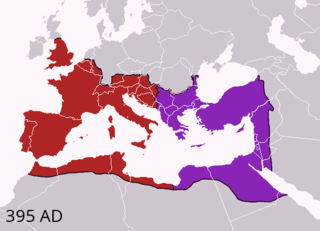The 400s decade ran from January 1, 400, to December 31, 409.
Year 385 (CCCLXXXV) was a common year starting on Wednesday of the Julian calendar. At the time, it was known as the Year of the Consulship of Augustus and Bauto. The denomination 385 for this year has been used since the early medieval period, when the Anno Domini calendar era became the prevalent method in Europe for naming years.
The 380s decade ran from January 1, 380, to December 31, 389.
The 430s decade ran from January 1, 430, to December 31, 439.
The 420s decade ran from January 1, 420, to December 31, 429.

Year 395 (CCCXCV) was a common year starting on Monday of the Julian calendar. At the time, it was known as the Year of the Consulship of Olybrius and Probinus. The denomination 395 for this year has been used since the early medieval period, when the Anno Domini calendar era became the prevalent method in Europe for naming years.
The 390s decade ran from January 1, 390 to December 31, 399
The 410s decade ran from January 1, 410, to December 31, 419.
The 360s decade ran from January 1, 360, to December 31, 369.
The 340s decade ran from January 1, 340, to December 31, 349.
The 350s decade ran from January 1, 350, to December 31, 359.
The 370s decade ran from January 1, 370, to December 31, 379.

Year 355 (CCCLV) was a common year starting on Sunday of the Julian calendar. At the time, it was known as the Year of the Consulship of Arbitio and Maesius. The denomination 355 for this year has been used since the early medieval period, when the Anno Domini calendar era became the prevalent method in Europe for naming years.

Year 421 (CDXXI) was a common year starting on Saturday of the Julian calendar. At the time, it was known as the Year of the Consulship of Agricola and Eustathius. The denomination 421 for this year has been used since the early medieval period, when the Anno Domini calendar era became the prevalent method in Europe for naming years.

Year 384 (CCCLXXXIV) was a leap year starting on Monday of the Julian calendar. At the time, it was known as the Year of the Consulship of Ricomer and Clearchus. The denomination 384 for this year has been used since the early medieval period, when the Anno Domini calendar era became the prevalent method in Europe for giving names to years.

Qin, known as the Former Qin and Fu Qin (苻秦) in historiography, was a dynastic state of China ruled by the Fu (Pu) clan of the Di peoples during the Sixteen Kingdoms period. Founded in the wake of the Later Zhao dynasty's collapse in 351, it completed the unification of northern China in 376 during the reign of Fu Jiān, being the only state of the Sixteen Kingdoms to achieve so. Its capital was Chang'an up to Fu Jiān's death in 385. The prefix "Former" is used to distinguish it from the Later Qin and Western Qin dynasties that were founded later.

Yan, known in historiography as the Later Yan, was a dynastic state of China ruled by the Xianbei people during the era of Sixteen Kingdoms.

Yan, known in historiography as the Southern Yan, was a dynastic state of China ruled by the Murong clan of the Xianbei during the era of Sixteen Kingdoms. Its founder Murong De was a son of Murong Huang and brother of Murong Jun and Murong Chui, and therefore was an imperial prince of both the Former Yan and Later Yan dynasties.

Murong Chui, courtesy name Daoming (道明), Xianbei name Altun (阿六敦), also known by his posthumous name as the Emperor Chengwu of Later Yan (後燕成武帝), was the founding emperor of China's Later Yan dynasty. He was originally a general of the Former Yan. He was a controversial figure in Chinese history, as his military abilities were outstanding, but as he was forced to flee Former Yan due to the jealousies of the regent Murong Ping, he was taken in and trusted by the Former Qin emperor Fu Jiān, but later betrayed him and established Later Yan, leading to a reputation of him as a traitor. Further, his reputation was damaged in that soon after his death, the Later Yan state suffered great defeats at the hands of Northern Wei dynasty's founder Emperor Daowu, leading to the general sense that Murong Chui contributed to the defeats by not building a sound foundation for the empire and by choosing the wrong successor. However he continues to be regarded as a general without parallel during his lifetime for having suffered no defeats throughout his career. Murong Chui's biography in the Book of Jin described him as seven chi and seven cun tall and having long arms.
The Sixteen Kingdoms, less commonly the Sixteen States, was a chaotic period in Chinese history from AD 304 to 439 when northern China fragmented into a series of short-lived dynastic states. The majority of these states were founded by the "Five Barbarians", non-Han peoples who had settled in northern and western China during the preceding centuries, and had launched a series of rebellions against the Western Jin dynasty in the early 4th century. However, several of the states were founded by the Han people, and all of the states—whether ruled by Xiongnu, Xianbei, Di, Jie, Qiang, Han, or others—took on Han-style dynastic names. The states frequently fought against both one another and the Eastern Jin dynasty, which succeeded the Western Jin in 317 and ruled southern China. The period ended with the unification of northern China in 439 by the Northern Wei, a dynasty established by the Xianbei Tuoba clan. This occurred 19 years after the Eastern Jin collapsed in 420, and was replaced by the Liu Song dynasty. Following the unification of the north by Northern Wei, the Northern and Southern dynasties era of Chinese history began.








